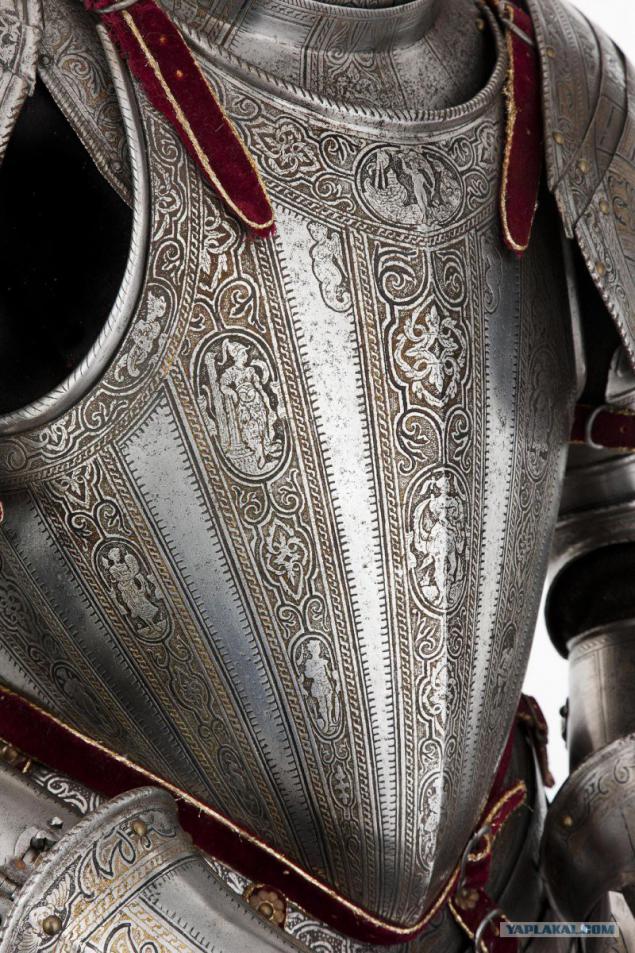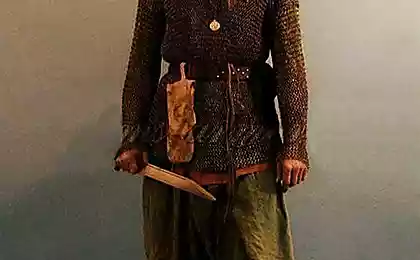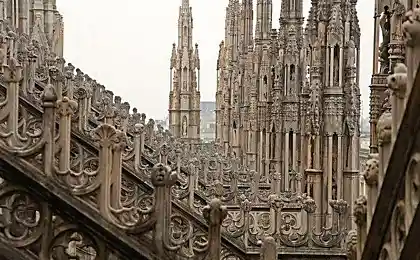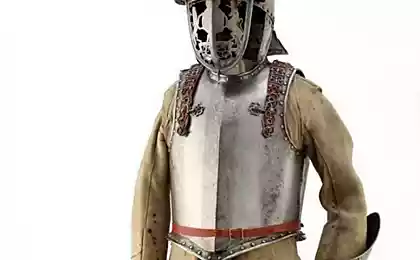1084
Milan armor.
Milan armor master Pompeo della Chiesa end of the XVI century.
Northern Italian composite armor. Place of origin - Milan, about 1590 One of the latest creations of the master Pompeo della Chiesa (Pompeo della Chiesa). He worked as a gunsmith from 1571 to 1591. Armor is not complete - some details have not survived: part of the elements on the right shoulders, the plate on the right thigh panel and probably Greaves. Translation from English, there may be some inaccuracies.
13 photo.

Dimensions: height (with stand) 191 x width 68 x height 50 cm.

Tight-fitting hard hat gated with a pronounced tilt forward. On the helmet has a low ridge with traces left over from multiple chop. The next stroke has on other elements of the armor. At the front, the front, the helmet is an observation slit (visor) to the central division.

It should be noted that the term "closed helmet" is used only in our time. During use, the helmet was called "armet».
The area is a traditional neck roll holder plume (feathers), made of brass.

On the bottom edge of the helmet passes the convex groove, which includes a protruding edge of the upper plate gorget (gorgets) with pairs of diagonal lines. Thus carried on the armor helmet mount, and more specifically, to the gorget.

On the right side are small holes for better ventilation inside the helmet. Visor - double, attached to the helmet on the two wing nuts and steel buckle on the right.

This mount allows the helmet to rotate freely from side to side on the collar. A gap between the helmet and the collar when it is absent, which gives a high degree of protection against weapons of the enemy. This method of fastening the helmet - the most difficult to manufacture, but the most perfect. To be able to tilt the head forward and back plate articulated collar made from three plates, with a certain degree of freedom with respect to each other.

Breastplate includes bib and naspinnik which are fixed on top of the belts. Probably one of the owners of the armor was a knight of the Order of Malta - on the front of the inside of the bottom of the breastplate engraved Maltese cross.

Breastplate finishes a small skirt of a single plate made so that it was convenient to sit in the saddle. To skirt four straps are attached two loin plate (tassety), consisting of seven plates left and six plates - right. Because of this, thigh guards look asymmetrical: the left significantly lower than the right. One of the plates on the right panel is lost.

Shoulders also consist of seven wafers each and also appear asymmetrically as in the right part of the elements has been damaged, and in the subsequent parts of those that remained, it was newly formed. They are attached to the top plate collar straps.

Bracers completely cover the wrists, are attached to the shoulder-belt in the area of the biceps. The elbow articulation used movable elbow of the three plates back and heart-shaped koutera front. This design allows relatively freely move his arms, while providing maximum protection.

Multi-sample fingerlike Plate Gloves with bell-shaped sleeves are made with a large number of plates and rivets that does not hinder movement and at the same time provides excellent protection.
It should be noted the excellent engraving of armor made with gold. Engraving is done very elegantly, without the kitsch.
HERE
Author fimusito

Source:
Northern Italian composite armor. Place of origin - Milan, about 1590 One of the latest creations of the master Pompeo della Chiesa (Pompeo della Chiesa). He worked as a gunsmith from 1571 to 1591. Armor is not complete - some details have not survived: part of the elements on the right shoulders, the plate on the right thigh panel and probably Greaves. Translation from English, there may be some inaccuracies.
13 photo.

Dimensions: height (with stand) 191 x width 68 x height 50 cm.

Tight-fitting hard hat gated with a pronounced tilt forward. On the helmet has a low ridge with traces left over from multiple chop. The next stroke has on other elements of the armor. At the front, the front, the helmet is an observation slit (visor) to the central division.

It should be noted that the term "closed helmet" is used only in our time. During use, the helmet was called "armet».
The area is a traditional neck roll holder plume (feathers), made of brass.

On the bottom edge of the helmet passes the convex groove, which includes a protruding edge of the upper plate gorget (gorgets) with pairs of diagonal lines. Thus carried on the armor helmet mount, and more specifically, to the gorget.

On the right side are small holes for better ventilation inside the helmet. Visor - double, attached to the helmet on the two wing nuts and steel buckle on the right.

This mount allows the helmet to rotate freely from side to side on the collar. A gap between the helmet and the collar when it is absent, which gives a high degree of protection against weapons of the enemy. This method of fastening the helmet - the most difficult to manufacture, but the most perfect. To be able to tilt the head forward and back plate articulated collar made from three plates, with a certain degree of freedom with respect to each other.

Breastplate includes bib and naspinnik which are fixed on top of the belts. Probably one of the owners of the armor was a knight of the Order of Malta - on the front of the inside of the bottom of the breastplate engraved Maltese cross.

Breastplate finishes a small skirt of a single plate made so that it was convenient to sit in the saddle. To skirt four straps are attached two loin plate (tassety), consisting of seven plates left and six plates - right. Because of this, thigh guards look asymmetrical: the left significantly lower than the right. One of the plates on the right panel is lost.

Shoulders also consist of seven wafers each and also appear asymmetrically as in the right part of the elements has been damaged, and in the subsequent parts of those that remained, it was newly formed. They are attached to the top plate collar straps.

Bracers completely cover the wrists, are attached to the shoulder-belt in the area of the biceps. The elbow articulation used movable elbow of the three plates back and heart-shaped koutera front. This design allows relatively freely move his arms, while providing maximum protection.

Multi-sample fingerlike Plate Gloves with bell-shaped sleeves are made with a large number of plates and rivets that does not hinder movement and at the same time provides excellent protection.
It should be noted the excellent engraving of armor made with gold. Engraving is done very elegantly, without the kitsch.
HERE
Author fimusito

Source:























